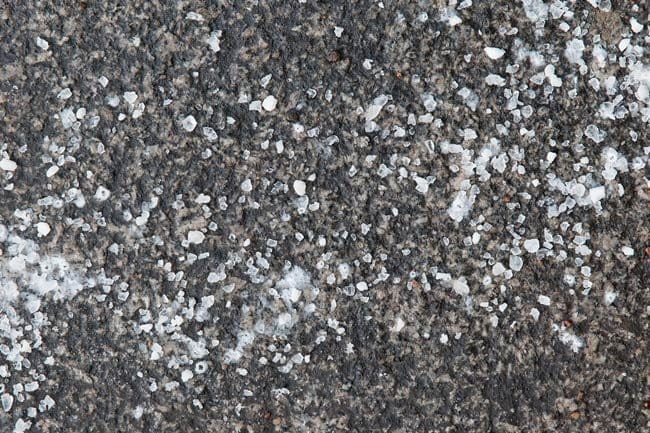Rock salt has long been used in the winter months to prevent ice formation on outdoor surfaces. Not only is it an abundant and natural material, but it’s also extremely effective.
Salt lowers the freezing temperature of the water, melts ice, and forms a brine when absorbed by the meltwater. It creates a knock-on effect, with brine spreading as snow melts – and as long as more salt is applied regularly, it can keep surfaces ice-free as long as temperatures don’t drop below 20 degrees Fahrenheit.
But while salt is effective and good at melting snow and ice, it does pose some risks to human and animal health. There are other side effects you should be aware of, too, relating to corrosion and possible damage to your property.
Let’s explore those.
Risks to Human and Animal Health

- Salt burn: When dry, rock salt may cause skin irritation and minor rashes if it comes into contact with skin, fur, and paws.
- Pets: Dogs and cats are likely to lick their paws. Ingestion can lead to diarrhea, vomiting, unusual drooling, fatigue, and disorientation. Salt burns can also occur in their gastrointestinal tract. Ingesting large quantities can be fatal and cause toxicosis.
- People: Always wear a mask when using rock salt as it can irritate the mouth, throat, stomach, and intestines if accidentally inhaled. This can lead to vomiting and/or diarrhea. Children who breathe in or swallow rock salt should receive immediate medical attention.
What About Sidewalks and Plants?
In the same way that rock salt can be harmful to animals and humans, it poses a threat to plants in your garden and near your sidewalks. The brine created by the salt and meltwater typically spreads into the surrounding soil. When too much rock salt enters the ground, it turns the soil toxic and kills plants.
Your sidewalks are at risk, too. As the rock salt brine seeps into paving stones and concrete, it lowers the pH level and makes the material less durable and stable. Corrosion can also occur, and the water that reaches deep into those cracks will gradually freeze and refreeze. This freeze-thaw effect is damaging not just to concrete but also to asphalt.
The effect is so bad that it makes you wonder why rock salt is used so widely!
Ways to Mitigate Rock Salt Dangers
There are eco-friendly and safer ice melt alternatives; however, these tend to be more expensive. If you are going to use sodium chloride, there are measures you can take to reduce rock salt dangers.
- Protective Gear: Wear gloves, boots, a mask, and eyewear when applying rock salt to prevent salt burns and ingestion.
- Storage Safety: Rock salt is hygroscopic and extracts moisture from the skin. It should be stored in airtight containers, away from moisture and sunlight, to minimize contact with skin.
- Plant Protection: Protect your garden with physical barriers like burlap, plastic, or wood. Only apply rock salt to pavements and walkways.
- Pet Well-being: When pets are outside, make sure they don’t drink rock salt brine. Once inside, wipe their paws to minimize the possibility of salt burn.
- Application: Salt on concrete has adverse effects. Use the correct type, and disperse in recommended quantities to reduce harming pets, children, lawns, flowerbeds, and pavements.
Safer Methods Of Ice Removal

At Earth Development, for more than 20 years we have been using a range of de-icing agents designed to protect your pavements and driveways. We also utilize a series of reagents that are safe around children and animals. Below are some suggested alternatives to reduce rock salt danger.
- Pet Safe Deicers: These are ordinarily manufactured from corn-based ingredients and are less harmful if touched or ingested, although medical attention will still be required if the latter occurs. There are several eco-friendly alternatives that, while pricier, are less harmful.
- Mixed Deicers: Mixing rock salt with sand decreases the amount of salt required, and the sand helps to loosen ice and snow. This is a good solution that works well on hard ice, making it easier to shovel and reduces salt risks.
- Snow-Melting Mats: This permanent and somewhat costly solution will prevent ice buildup. It prevents slip and fall accidents and reduces rock salt danger as less product is needed.
- Shovel First: Shovel early and often during a snowstorm to prevent the snow from becoming compact and turning into ice. The more snow removed early on, the less ice to get rid of later.
Find Out How Earth Development Can Help You
For more information about our wide range of de-icing agents, as well as our snow removal services in Wisconsin, Ohio, Minnesota, and beyond, don’t hesitate to get in touch!
Get a free quote online or give us a call, and we’ll walk you through every option available. We’ll even arrange for a member of our team to visit your property and discuss your needs.
We look forward to hearing from you!
